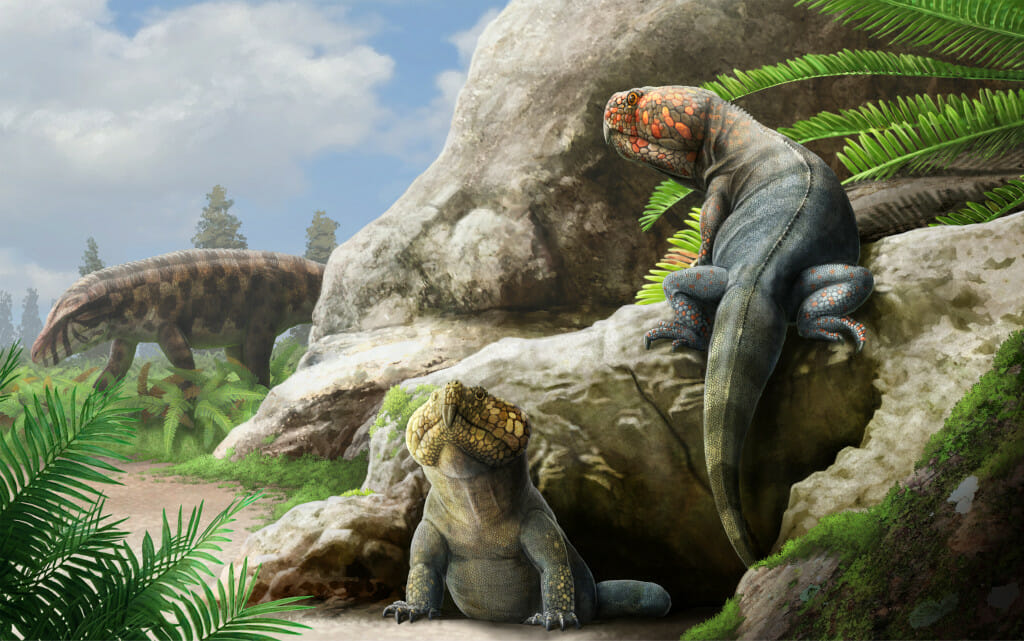Newly described ancient reptile named in language of First Nations where fossils were found

This artist’s depiction shows how Beesiiwo cooowuse may have appeared while roaming the Earth between 250 and 227 million years ago. The newly described rhynchosaur species was named in the language of the northern Arapaho, who live where its fossils were discovered in central Wyoming. Gabriel Ugueto
Beesiiwo cooowuse was a squat, herbivorous relative of modern crocodiles and birds that had a beak-like mouth and roamed the globe between 250 and 227 million years ago. Its name, pronounced “Bah-se-wa’ ja’ aw-wu sa,'” speaks to the modern-day location where its fossilized remains were unearthed: “big lizard from the Alcova area” of central Wyoming.
A new study, published April 10 in the journal Diversity, is the first to describe the new rhynchosaur species. Named by tribal elders in a collaboration between officials of the Northern Arapaho Tribal Historic Preservation Office and paleontologists from the University of Wisconsin–Madison, the new study also represents part of a growing number of partnerships seeking to decolonize scientific practices.
Indeed, this is the first Western-science species to be named in the language of the Arapaho people, upon whose ancestral lands the fossil specimens originated. Beesiiwo is also the first of several ancient animals to be named as a result of this partnership and renewed paleontological involvement in the area.
The North American west is well known for its incredible fossil record and the past ecosystems they represent, but fossil collection and study in the region have historically involved little partnership at the local level, especially with First Nations communities.
The Beesiiwo fossils were collected from the Popo Agie Formation, a portion of exposed rock in parts of the northern Rocky Mountains, including the Southern Bighorn Mountains in Wyoming, that date from the late Triassic (237-227 million years old).
“This is an exciting place to do fieldwork because this geological formation hasn’t really been studied in nearly a century,” says David Lovelace, a UW–Madison vertebrate paleontologist and author on the paper.
A scientist at the University of Wisconsin Geology Museum who grew up in Wyoming, Lovelace leads undergraduate field experiences out west where students help conduct excavations on public lands that are the ancestral and traditional lands of many First Nations, including the Northern Arapaho and Eastern Shoshone.
In recent years, Lovelace and several current and former UW–Madison students, including lead author Adam Fitch, have developed a partnership with tribal representatives of the Eastern Shoshone and Northern Arapaho on the Wind River Reservation.
They’ve also developed relationships with Fort Washakie Schools (FWS) on the Wind River Indian Reservation in Wyoming and have engaged with students to analyze fossils and help name newly identified species. They have also focused on getting students in the field to work with scientists. Tribal elders have been involved in the entire process.
“And so,” says Lovelace, “we get this multicultural, multigenerational interaction in the field where elders, FWS students, UW–Madison students and scientists are all working together to integrate Western science, Native science and traditional ecological knowledge.”
For Lovelace, who has participated in excavations in the region for almost three decades, it’s about respecting local practices, Native sovereignty and more meaningfully respecting Native ways of knowing.
He also says that he and the UW–Madison students who have participated in the field excursions have adopted new practices to respect the cultural customs and beliefs of the local First Nations communities.
“It’s just being present, and fully focused on the fact that we are here as guests visiting this land, and this land has not only a deep cultural history, but it is an active part of that vibrant culture” he says.



